Spit into the Wind!
After reading Mezrabad's review of Human Cannonball, and the subsequent comments about the classic game Artillery, I remembered a graphical hack I did of Kirk Crawford's version of Artillery for the Mac.
I created this back around 1990. Re-titled "Spit into the wind", it featured two caricatures of my college profs hocking loogies at each other. So I thought, "Hey! This is another (fanfare please)... Stupid Game Idea!" It would be a natural for the 2600. While there's already an Artillery-type game in perpetual homebrew development, as well as Xonox's Artillery Duel, I'm unaware of any 2600 game in which you spit at each other!
As a little background, the two profs were design teachers at an art college I went to. I won't reveal their real names, but we called them Ramblin' Ray, and Butt-Ug Lee. Here are a couple of caricatures I drew of them back-in-the-day.
Ray:
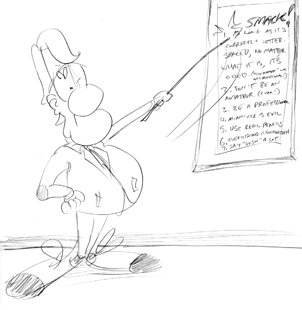
Butt-Ug:
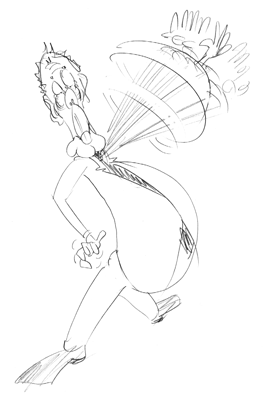
(In case you're wondering, he tended to flail his arm around a lot and grab his butt.)
The irony isn't lost on me, that as I'm teaching college now, probably every last one of my students is similarly caricaturing me. (One of the hazards of working in the Character Animation department.) Well, what goes around comes around. ![]()
Anyway, after a little digging, I actually found "Spit into the Wind". (Some days it's good to be a pack-rat.)
It doesn't completely work though, now. When I click to change the angle and amount of Cheetos™ (formerly gunpowder), the numbers just jump from minimum to maximum. (The newer version on Kirk's site does work properly under OS X's Classic, however. It just doesn't have the modified graphics.)
I'd completely forgotten that I'd also hacked the bird into a little flying version of Ray. ![]()
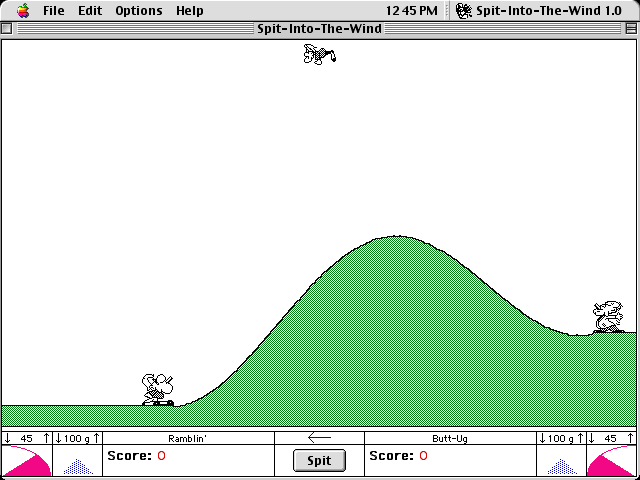
Here's the application icon, of Ray getting hit in the face:
![]()
To do those graphics on the 2600 though, I'd have to use both sprites for each character to get reasonable detail. Although as long as they were kept vertically separated, it should work okay.


The basic premise is simple. You have these two guys, facing each other, with some terrain in between them. There's a wind blowing (of course), and you have to determine how many Cheetos™ they need, and at what angle they need to spit, in order to hit the other guy. Once the parameters are set, you hit "Fire" and they both shoot at the same time. If they both miss, you adjust, and fire again.
One nice feature of Artillery (which probably can't be duplicated on the 2600) was that the trajectory for each shot was shown as an arc on screen, and was left in place so you could see how much each shot got changed. Still, I think it'd be a pretty fun game even without that.
And it'd be a blast to do the manual for it. ![]()
Edit: Well, I decided to see what a mockup of this might look like. Now first, I'm not sure an asymmetrical playfield can be done the way I'd like it to. But the big problem I ran into was, well... big. The sprites were way too big. You couldn't not hit them...
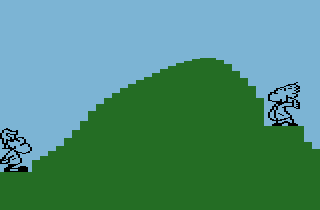
So that meant I had to at least try to make the sprites smaller. Much smaller. I wasn't sure I could come up with 8-pixel-wide versions of these guys, but I think they turned out pretty well...
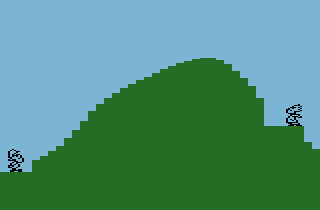
This also has the handy side-effect of not needing to keep the sprites vertically separated anymore. ![]()
With that solved, I continued mocking up the rest of the elements...
It'd be nice for each player to be able to enter a three-letter name for themselves. Their scores would be at the top.
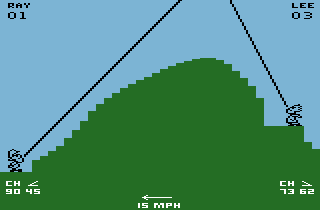
At the bottom is the amount of Cheetos™ per shot, the angle they spit at, and the wind speed and direction.
The diagonal lines represent the angle at which they'll shoot. Basically, an "aimer". Once they shoot, the aimer disappears, and their shots follow a parabolic arc.
Ideally, the terrain would be randomly generated each round, but provide platforms wide enough for each sprite to stand on (or alternately, just store a bunch of pre-designed ones). One thing I don't care for in either Artillery Duel or Incoming!, is that the sprites can just kind of hang out over the playfield.
Joystick controls couldn't be simpler: up/down for Cheetos™, left/right for angle, and fire locks it in. When both players have pressed fire, the spitting begins! In a one-player game, the computer controls the other character (but you get to choose).
Now all we need is a big bag of Cheetos™! And a programmer. ![]()
(Could make a nice mini-game compo entry. ![]() )
)


22 Comments
Recommended Comments